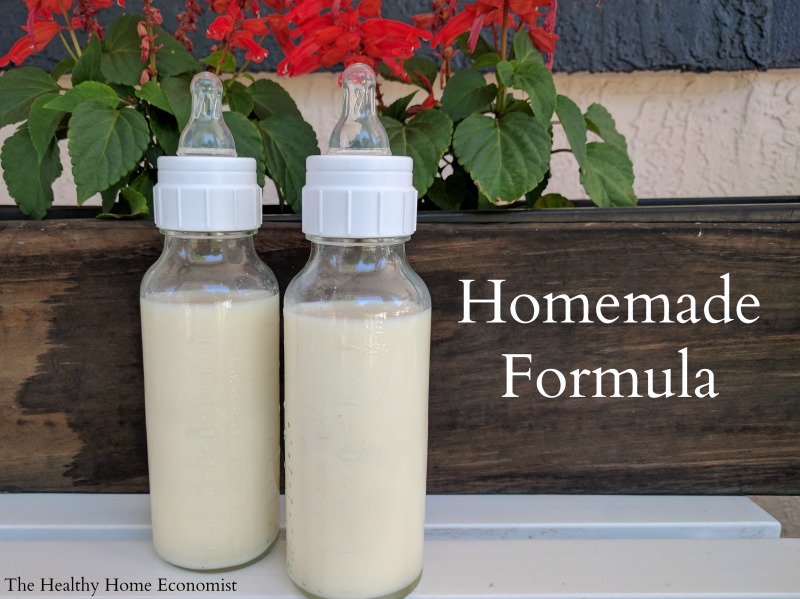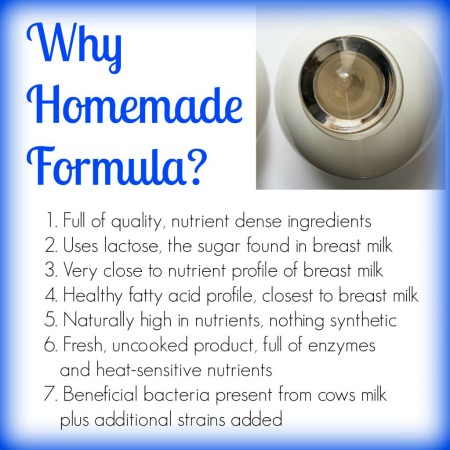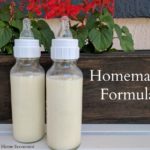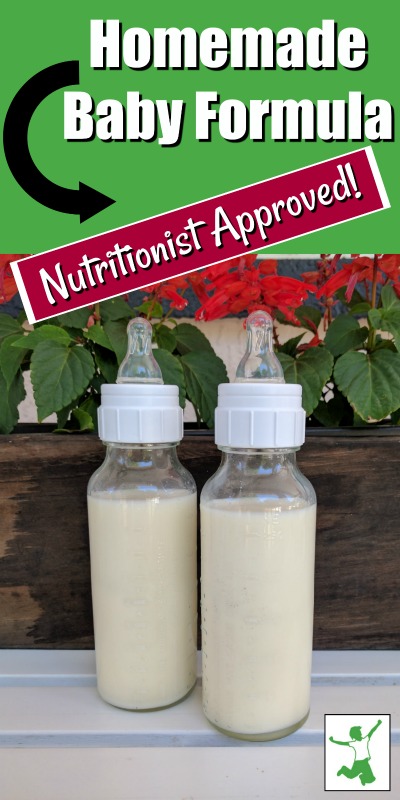Table of Contents[Hide][Show]
A nourishing homemade baby formula using safe, whole ingredients. This recipe was developed and tested by Dr. Mary Enig, a PhD Nutritionist and originally published in Nourishing Traditions cookbook in 1996. It was formulated to match breastmilk as closely as possible and is also suitable for infants. Source: Weston A. Price Foundation

There is no doubt that breastfeeding your baby is the best option for the child’s long-term health and development. Human breastmilk from a well-nourished mother is the perfect food for baby. However, in circumstances where the child is adopted or the Mother finds herself unable to breastfeed, formula feeding becomes necessary. In those cases, homemade baby formula is best.
Using a baby formula recipe that closely matches the nutritional profile of breastmilk is a far better choice than even organic baby formula from the health food store. More on this below.
Note: Donor programs are widely available for human breastmilk. But, the diets of the donor mothers are unknown and most likely nutritionally insufficient. In addition, breastmilk banks pasteurize the donated breastmilk which destroys much of the nutritional benefit. Unless you are fortunate to have a trusted and direct donor milk source in your community, avoid this option!
Dangers of Commercial Formula
Commercial formulas are always a poor choice for a number of reasons. First of all, formula manufacturers line the cans with the chemical BPA. This substance disrupts hormone development and is a probable contributor to early puberty in girls, and ADHD, urogenital abnormalities, and other ills in boys.
The European Food Safety Authority found that canned commercial formula is a significant source of BPA for infants, exposing the child to 13mcg of BPA per kg of body weight per day! BPA-free formula cans are no better. The chemical BPS is typically used instead which is just as dangerous.
Beware that manufacturers pack even organic commercial formula like Earth’s Best in BPA cans. Worse, they use organic brown rice syrup as the primary sweetener which is known to be frequently contaminated with arsenic.
In addition, all commercial milk formulas are processed at extremely high temperatures which violently denature the fragile milk proteins, render them allergenic, and add carcinogens to the final product. Soy infant formula is the worst. Obscenely high processing temperatures not only denature the proteins but large levels of phytic acid in soy block mineral absorption by the infant. Moreover, soy-based plant estrogens disrupt the hormonal development of the baby!
It seems that for the concerned Mother who is unable to breastfeed, learning how to make baby formula at home with safe, pure ingredients is the most prudent way to go!
Why Make Homemade Formula Even if You Are Breastfeeding
In the video below, I show you how to make your own safe, healthy raw milk homemade formula for your baby.
The recipe I follow was originally published in the cookbook Nourishing Traditions in 1996 and developed by Dr. Mary Enig.
Even though I breastfed each of my children for at least 2 years, I made this exact formula for my own children when I was away for the day or the evening as pumping was not an option that worked well for me.
I even used this homemade formula for an entire day once when I had some dental work done and was advised to pump and discard for 24 hours.
As a result, even successfully breastfeeding Moms can use this wonderful homemade formula as a supplement when necessary to their own nutrient-dense breastmilk!
It is advised that even breastfeeding Mothers have the ingredients for this formula on hand for an emergency. If Mom is sick or otherwise unable to nurse, Dad can step in and make this safe alternative until Mom is back on her feet. It takes a few days to a week to gather all the ingredients together to make this formula, which is why I advise having them on hand at all times.
Homemade Most Nutritious
The image below lists the reasons why it is worth it nutritionally to make formula yourself for your precious baby!
You can order all of the required ingredients for the homemade baby formula in one package from this reputable, vetted source.
Moms who have successfully used this formula feeding your children, please post about your experience in the comments section to encourage those who are considering it and need some Mom to Mom encouragement!

Where to Source Quality Milk
The most widely available grass-fed milk around the world is from cows. This is usually the most budget-friendly and easily sourced milk for this recipe for homemade formula.
If only goat milk is available in your area, this recipe for goat milk baby formula can be used instead. When using milk from ewes, please refer to the linked article for an adjusted recipe; one of the benefits of sheep milk is that it is higher in healthy fats than either goat or cow milk.
Camel milk formula is another option that is a particularly digestible form of dairy and growing in popularity around the world.
Alternatively, you can use low temp (vat) pasteurized, non-homogenized whole milk cultured with a piima or kefir starter. Then substitute the piima milk or kefir for the raw milk portion of the formula recipe. Cold-pressed raw milk also must be cultured before using it as it contains no probiotics.
Do NOT use ultrapasteurized (UHT) milk even if organic as it is too highly processed and extremely allergenic!
It is also best to avoid all types of powdered milk for this recipe. The factory process of making milk powder reduces nutrition considerably and denatures it, which makes it more likely baby will have an allergic reaction.
Dairy Allergy Option
If all types of dairy prove unsuitable for your baby, make this nondairy baby formula recipe instead. It uses a base of homemade bone broth as a substitute for milk. It is important not to utilize a plant-based or otherwise vegan baby formula recipe.
Avoid buying bone broth to make the dairy-free formula. Make it yourself! Manufacturers of commercial bone broth, even if authentic, may water down the end product. This is apparent if it does not gel when chilled in the refrigerator.
Many brands have toxic packaging issues as well. If you must buy it in a pinch, see my shopping guide page for vetted brands that are safe.

Homemade Baby Formula Recipe (for infants too)
A nourishing baby formula recipe you can make at home with safe, whole ingredients developed and tested by a PhD nutritionist to match breastmilk as closely as possible. Also suitable for infants.
Ingredients
- 2 cups raw cow milk OR organic whole milk yogurt
- 1 7/8 cups filtered water
- 1/4 cup liquid whey
- 4 Tbl lactose
- 1/4 tsp Bifidobacterium infantis powder
- 2-4 Tbl raw or pasteurized cream
- 1/2 tsp cod liver oil unflavored
- 1/4 tsp butter oil unflavored
- 1 tsp sunflower oil preferably organic
- 1 tsp extra virgin olive oil preferably organic
- 2 tsp virgin coconut oil preferably organic
- 2 tsp nutritional yeast
- 2 tsp gelatin
- 1/4 tsp acerola powder
Instructions
-
Fill a 2 cup Pyrex measuring cup with filtered water and remove 2 TBL (this will give you 1 7/8 cup water).
-
Pour about half the water into a pan and turn burner on medium.
-
Add the gelatin and lactose and let dissolve, stirring occasionally.
-
When gelatin and lactose are dissolved, remove pan from heat and add the rest of the water to cool.
-
Stir in the coconut oil and butter oil until melted.
-
Put remaining ingredients in a glass blender.
-
Add the water mixture and blend for about 3 seconds.
-
Place formula in glass baby bottles or a glass jar and refrigerate.
-
Before giving to baby, warm glass bottle in a pan of hot water or a bottle warmer. NEVER microwave baby bottles!
Recipe Video
Recipe Notes
If using raw cow milk from holstein cows, use 4 Tbl of extra cream (otherwise use 2 Tbl extra cream).
If choosing to make this homemade formula with camel milk, be sure to include 4 Tbl extra cream as camel milk is lower in cream than cow milk.
Do not use high oleic sunflower oil. Use only the brand recommended in the ingredients list which is cold pressed, organic, unrefined, and low oleic.
*Do NOT use powdered whey from the store as it is denatured. Avoid whey from making cheese as it will curdle the formula.
*Do not substitute pasteurized or powdered milk as these are heavily processed, denatured and allergenic foods.
*Do NOT use ultrapasteurized (UHT) cream. It is highly allergenic. Raw or pasteurized cream is acceptable.
*Do NOT use fish oil or krill oil instead of high vitamin cod liver oil as they do not contain any Vitamin D and very little to no Vitamin A.
Collagen powder may be substituted for the gelatin in a pinch (more on peptides in baby formula in this article).
If you are wondering where is the iron in homemade baby formula, this article provides an explanation.
If baby experiences constipation using this formula, try adding 1 tsp of molasses to each batch. This should help move things along.
How to Transition to DIY Formula
Once you’ve viewed the video, gathered the ingredients, and made your first batch, how do you feed it to your baby for the first time?
It is important not to switch all at once as this can cause gas, excessive spit-up, or an uncomfortable change in diaper habits such as constipation or overly loose stools.
Start by giving your baby three-quarters of the old formula blended with one-quarter of the homemade. Try this ratio for a day or two and see how your infant responds.
If no digestive upset or major change in diaper habits occurs, increase the amount to a 50-50 blend of old formula to homemade. Observe for another day or two as before.
If no major issues, increase once again to three-quarters homemade formula to one-quarter old formula. If baby does well on this blend for a third time, you are ready to fully transition to the homemade formula.
At any time during the transition, symptoms of intolerance emerge, back up to the previous successful blend ratio and stay there for a day or two before attempting to increase once again.
Homemade Formula FAQ
Weston Price Foundation
Feeding an Adopted Baby
Traveling Tips with Baby Formula Made at Home
Iron in Baby Formula
Collagen Peptides instead of Gelatin for Homemade Formula?










Raw cow’s milk is unavailable in our area. I’m really hoping to use this recipe by replacing it with something. Can you let me know how to go about doing this? Thanks so much.
HELP!
I started my baby on the homemade formula with the raw cow milk a week ago i thought everything was going good 2 days after starting the formula her tummy was getting super bloated and she was throwing up some gushy things and a lot of it. I took out the yeast completely and only added one teaspoon of gelatin when it calls for two. Her belly was still getting bloated but not as much and she was not throwing up so thought i would keep an eye on it. Today my daughter threw up a lot with chunks of some white things when i picked it up and felt it was super hard and it felt like rubber. I can’t believe my baby had that stuff in her belly and that it passed through her throat. It is very scary. I really want this homemade formula to work i don’t want to go back to commercial formula and I’m not able to breastfeed. Does anyone know whats causing this? Which ingredients could possibly be causing this? How can i start the process of elimination and how does it work? Any help would be greatly appreciated. Thank you
Take out the nutritional yeast and gelatin and see how that works. If still a problem, make the formula and substitute the raw milk portion with raw milk kefir (see my video on how to easily make it yourself). If that still produces problems, try the hypoallergenic homemade formula (video and recipe on my blog).
Thank you. I took out the yeast and gelatin completely and she has been doing very well. She still spit us here and there but not as much and not those big chunks of rubber feel like. Thank you. I have noticed she is not eating as much as before and goes longer without feedings. When i try feeding her she refuses to eat for a while. Is it becuase this forumula is keeping her fuller longer?
Thanks!
Hi Jenny..I started to give my baby few days ago..at first it went well but days after it happened also to my baby exactly everything that said here.and also in your last question. That’s what I noticed with my baby, she is not eating as much as before and goes longer without feedings. I would like to know the answer of that also.
Hi Jenny,
Your daughter might actually be lactose intolerant or have a milk allergy. Although removing the yeast and gelatin may have yielded less and milder vomiting, if her abdomen is still bloating, feeling firm, and she’s refusing to eat/eating less DO NOT automatically assume she’s staying fuller longer. I’d consult your pediatrician. If you’re worried about telling your pediatrician about the raw milk formula, you could just say you were trying to gradually introduce animal’s milk into her diet and found she may have had a reaction and you want her tested for lactose intolerance and milk allergies. Or you could be more concerned that YOUR want to feed your child a healthier alternative to commercial baby formula may be doing her more harm than good.
tl;dr: Test your daughter for lactose intolerance and milk allergies before you assume that what you’re feeding her is better for her.
Can you show any trustworthy sources claiming that commercial formula is that bad, please? That would make your page more trutsworthy, so far I am just as sceptical to your proffessionality as I am to commercial formula.
Commercial formulas are actually very bad!! One of the first ingredients is corn syrup!! Which is GMO-genetically modified organism- also is just a sweetener. Top brand formulas are basically a big scam on mothers because they know we need it as unfortunate as it is. My daughter is still currently on Similac Soy, which is a double disaster lol because soy is also one of the top GMO foods! We are still in search of a natural way to nourish her, a lot of trial and error, and we also let her nourish on all organic foods to stay away from those GMO’s!! the research makes you very worried but just keep trying. Look up related topics with what I just talked about and you will uncover a whole new world of the things that we think are healthy but are actually poison in the long run. I may sound like one of those moms that worry too much but trust me the only thing that really gets discussed in detail in our household is what goes into our bodies everything else is a free for all lol…….You have a good day Laura and good times researching!
Can this formula be frozen at all? If so, for how long? I am having my first baby in May and do plan to breast feed but would like this to be hand in case it is needed. Thanks!
Yes, it can be frozen for a few weeks. Best to make it fresh though.
Hi Sarah, my daughter only uses 20 of the 36 oz daily so I’ve been freezing it so far. Is there a way to half the recipe so I can blend it fresh every day? The idea of 1/8 tsp is kind of intimidating. Or should I just keep making fresh for two days and giving her frozen for two days?
Just halve the recipe … 1/8 of a tsp is on my measuring spoon. Not so small that it can’t be done 🙂
How many months should we keep baby on this formula? Should we increase or decrease any ingredients as baby gets older?
For instance if baby is 3 months old and has been on this formula for 2 months, should I be giving her more milk?
Thanks!
Until the child is one year old. Then you can switch to plain, whole raw grassfed milk.
Thanks, Sarah!
Hi there,
I’ve been feeding my daughter (4 months) this formula for about 3 weeks now and it seems that she is struggle with her BMs. She sometimes cries and the BM is green and seedy, but mostly hard and solid, not wet. Is that normal? She also seems to be in discomfort right after feeding. Is this a sign of a milk allergy? I am lactose intolerant, but have been drinking the raw milk with little side effects unlike what I got from pasteurized milk. Any ideas? Thanks!
Try fermenting the raw milk into raw kefir (I have a video on this … super simple) and make the formula with the kefir instead of the milk (same amount per batch).
This additional fermentation and probiotics usually will do the trick.
Awesome. I’ll definitely try the raw kefir in the formula.
Also, last questions, what is the purpose of the nutritional yeast?
Thanks Sarah!
This adds extra B12 and other B vitamins. If after trying the kefir, baby is still having issues, you can try removing the yeast and then the gelatin and see if that helps.
It’s ok that is gels. As it warms up it will liquify again.
We are getting a wonderful gift this spring–baby number three! At first, I was shocked and intimidated by the 16 month age difference between two and three. Then I understood my plan is not always God’s plan… In any case, I’ve followed the WAPF pregnancy diet for years, but still felt it would be best for my eight-month-old to have homemade formula through the pregnancy. I’m ambivalent about the nutritional yeast, so I leave it out, as baby gets lots of liver. I make the formula every two days. He has loved it! As an added bonus, his teething pain and sleeping have improved. I suspect it’s the fatty acids–he is definitely taking in more formula than he was breast milk. He has put on a little more chub, is big for his age, and in all ways continuing to thrive. Anyway, nothing but great experiences. And it’s an option I’m so thankful to have!
hi I am in shock at how bad sore bought formulas are I had NO IDEA!! as I read most of the comments it seems so complicated the video seems easy but if your baby doesn’t tolerate something in the original recipe how do you all know what to change? I started the first wk with breast feeding my baby was 3 wks early she wouldn’t latch. I pumped however my supply dried up! now she is on similac sensitive formula and seems to have discomfort or pains when shes pooping or has to poop but her stools aren’t hard so ive kept her on this formula. I want to try the at home formula but this is very confusing. anyone able to help give me suggestions due to what formula I have her on at the moment? also shes 3 wks old if that helps at all. and can anyone tell me what it costs on average a month to make this formula?
Okay, now instead of being constipated, she is pooping like 4 to 5 times a day. How long should it take her digestive system to adjust to this formula? Or should I just switch back to the broth formula? I would rather leave her on the cow’s milk because she seems more energetic and fuller this way, but I don’t want to make her sick either.
My babies always pooped several times a day when I was breastfeeding.
Yes, we have had a lot of problems and not been able to breastfeed. On commercial formula she pooped once a day. On the meat based formula she pooped every other day, but it wasn’t hard. She was constipated on the milk formula at first and now it pooping like 5-6 times a day. There is substance to it, but it can be pretty watery too. She does have a a very red bottom and is starting to get a little bit of a rash on her behind. I left out the yeast to see if that helps. She is 5 months old now and I am a little concerned because she has been gaining about 2lbs a month, but since I started her on homemade formula she has increased maybe half a lb in 3 weeks. and seems to not be increasing the last week. She does have a happy and energetic demeanor, but I am worried about upsetting her stomach and her gaining weight as she should. I would go back to meat based formula, but that didn’t seem like she pooped enough. I just don’t know what I should expect or how long I should wait before I know whether the milk is causing a problem or not.
Nevermind, she just soaked me in throw up, so we are going back to meat based formula. Thank you for your help.